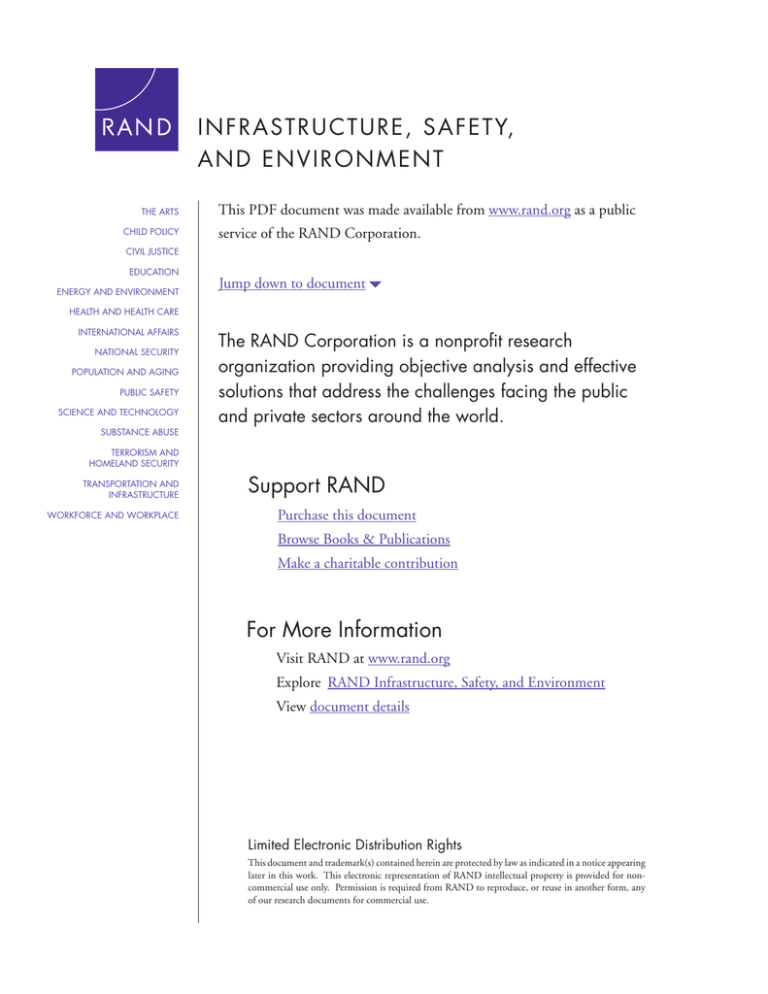
INFRASTRUCTURE, SAFETY,
AND ENVIRONMENT
THE ARTS
CHILD POLICY
This PDF document was made available from www.rand.org as a public
service of the RAND Corporation.
CIVIL JUSTICE
EDUCATION
ENERGY AND ENVIRONMENT
Jump down to document6
HEALTH AND HEALTH CARE
INTERNATIONAL AFFAIRS
NATIONAL SECURITY
POPULATION AND AGING
PUBLIC SAFETY
SCIENCE AND TECHNOLOGY
SUBSTANCE ABUSE
The RAND Corporation is a nonprofit research
organization providing objective analysis and effective
solutions that address the challenges facing the public
and private sectors around the world.
TERRORISM AND
HOMELAND SECURITY
TRANSPORTATION AND
INFRASTRUCTURE
WORKFORCE AND WORKPLACE
Support RAND
Purchase this document
Browse Books & Publications
Make a charitable contribution
For More Information
Visit RAND at www.rand.org
Explore RAND Infrastructure, Safety, and Environment
View document details
Limited Electronic Distribution Rights
This document and trademark(s) contained herein are protected by law as indicated in a notice appearing
later in this work. This electronic representation of RAND intellectual property is provided for noncommercial use only. Permission is required from RAND to reproduce, or reuse in another form, any
of our research documents for commercial use.
This product is part of the RAND Corporation conference proceedings series. RAND
conference proceedings present a collection of papers delivered at a conference. The
papers herein have been commented on by the conference attendees and both the introduction and collection itself have been reviewed and approved by RAND Science
and Technology.
Nanomaterials
in the Workplace
Policy and Planning Workshop on
Occupational Safety and Health
James T. Bartis, Eric Landree
Prepared for the National Institute for Occupational Safety and Health
INFRASTRUCTURE, SAFETY, AND ENVIRONMENT
The research described in this report was sponsored by the National
Institute for Occupational Safety and Health. This research was
conducted under the auspices of the Safety and Justice Program within
RAND Infrastructure, Safety, and Environment (ISE), a division of the
RAND Corporation.
The RAND Corporation is a nonprofit research organization providing
objective analysis and effective solutions that address the challenges
facing the public and private sectors around the world. R AND’s
publications do not necessarily reflect the opinions of its research clients
and sponsors.
R® is a registered trademark.
© Copyright 2006 RAND Corporation
All rights reserved. No part of this book may be reproduced in any
form by any electronic or mechanical means (including photocopying,
recording, or information storage and retrieval) without permission in
writing from RAND.
Published 2006 by the RAND Corporation
1776 Main Street, P.O. Box 2138, Santa Monica, CA 90407-2138
1200 South Hayes Street, Arlington, VA 22202-5050
4570 Fifth Avenue, Suite 600, Pittsburgh, PA 15213
RAND URL: http://www.rand.org/
To order RAND documents or to obtain additional information, contact
Distribution Services: Telephone: (310) 451-7002;
Fax: (310) 451-6915; Email: order@rand.org
Summary
Over the past few years, various organizations inside and outside of government have focused
attention on the lack of understanding of the human health and environmental consequences
of nanomaterials. Reports on the human health risks of nanotechnology frequently mention
the importance of managing the occupational health risks associated with exposure to nanomaterials. Workers involved with the manufacture or handling of nanomaterials are viewed as
being especially susceptible to receiving high exposures to those materials.
The chemical and physical properties of engineered nanomaterials can vary dramatically
from those of the bulk forms of the same materials. Nanomaterials represent new substances
that require research, analysis, and testing to determine whether they pose health risks and, if
so, how those risks can be managed.
On October 17, 2005, the RAND Corporation hosted a workshop on nanotechnology
and occupational safety and health. The workshop focused on the policy and planning issues
(as opposed to scientific issues) required to understand the options available to NIOSH in formulating and implementing its strategic objectives to protect the safety and health of workers
exposed to nanoscale materials. While the workshop discussions ranged over a broad series
of topics, there were four problem areas that were repeatedly raised during the course of the
meeting:
1. Knowledge gaps related to health risks and worker protections are raising concerns
regarding liability that may stymie the development and introduction of new
nanomaterials.
2. Efforts to address the occupational risks associated with specific nanomaterials are
being impeded by shortfalls in fundamental scientific knowledge common to broad
classes of nanomaterials.
3. Public and private resources and funds being allocated to understanding the
occupational, health, and environmental risks of emerging nanomaterials are not
commensurate with the pace of development of new nanomaterials.
4. Cooperation among federal agencies and between the public and private sectors is
essential for progress.
ix
x
Nanomaterials in the Workplace: Policy and Planning Workshop on Occupational Safety and Health
Based on the proceedings of the workshop, presentations at the Second International
Symposium on Nanotechnology and Occupational Health and discussions with NIOSH
researchers in preparation for the workshop, key components of the overall federal effort for
managing the occupation risks of nanotechnology need to be reconsidered:
• Because of other demands on their expertise and resources, NIOSH and agencies that
have a role or interest in managing the occupational hazards of engineered nanomaterials
can bring only limited funds and personnel to the table. The limited resources that are
available should be directed to critical federal roles, such as establishing toxicology fundamentals and providing near-term assistance to protect workers from currently in-use
and emerging nanomaterials.
• Greater interaction and cooperation is needed between the nanotechnology development
and user communities and NIOSH and related agencies that are responsible for advancing worker safety and health.
• The federal government’s efforts to develop the knowledge base required to manage the
occupational risks associated with nanomaterials should be undertaken by way of a unified federal strategy that assures appropriate safety and health research, testing, and assessments for managing the risks of occupational exposures.
• The level of federal resources devoted to the safety and health risks associated with nanotechnology in the workplace needs to be reexamined, including the currently planned
level of investments in workplace-risk management.





